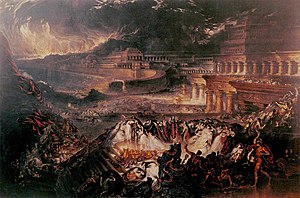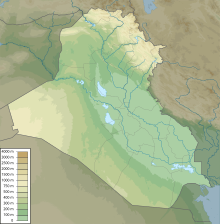| Battle of Nineveh | |||||||
|---|---|---|---|---|---|---|---|
| Part of the Medo-Babylonian conquest of the Assyrian Empire | |||||||
 Painting titled The Fall of Nineveh by John Martin | |||||||
| |||||||
| Belligerents | |||||||
|
Neo-Babylonian Empire Median Kingdom | Neo-Assyrian Empire | ||||||
| Commanders and leaders | |||||||
|
Nabopolassar Cyaxares | Sinsharishkun † | ||||||
Location within Iraq | |||||||
The Battle of Nineveh, also called the fall of Nineveh is conventionally dated between 613 and 611 BC, with 612 BC being the most supported date. Rebelling against the Assyrians, an allied army which combined the forces of Medes and the Babylonians besieged Nineveh and sacked 750 hectares of what was, at that time, one of the greatest cities in the world. The fall of Nineveh led to the destruction of the Neo-Assyrian Empire as the dominant state in the Ancient Near East over the following three years.[2] Archeological records show that the capital of the once mighty Assyrian Empire was extensively de-urbanized and depopulated in the decades and centuries following the battle. A garbled account of the fall of the city later led to the story of the legendary king Sardanapalus.
Babylon became the imperial center of Mesopotamia for the first time in over a thousand years, leading to the Neo-Babylonian Empire, claiming imperial continuity as a new dynasty.
- ^ A Companion to Assyria "The decisive blow came in 612, when Babylonian and Median armies , after a two-month long siege, conquered Nineveh"
- ^ Georges Roux - Ancient Iraq p 376
